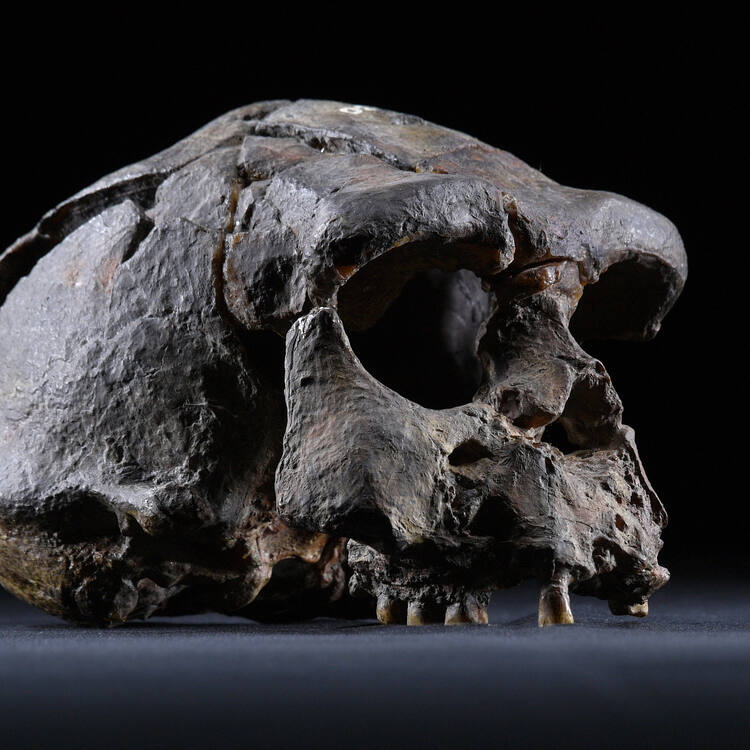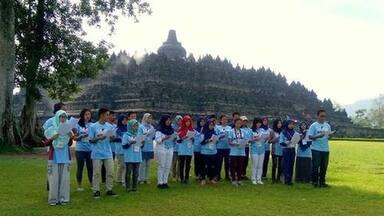Sangiran Early Man Site
Sangiran Early Man Site
Excavations here from 1936 to 1941 led to the discovery of the first hominid fossil at this site. Later, 50 fossils of Meganthropus palaeo and Pithecanthropus erectus/Homo erectus were found – half of all the world's known hominid fossils. Inhabited for the past one and a half million years, Sangiran is one of the key sites for the understanding of human evolution.
Description is available under license CC-BY-SA IGO 3.0
Site des premiers hommes de Sangiran
Une campagne de fouilles menée de 1936 à 1941 permit de mettre au jour le premier fossile d'hominidé de ce site. Des fouilles ultérieures ont exhumé cinquante fossiles de Meganthropus palaeo et Pithecanthropus erectus/Homo erectus , soit la moitié des fossiles d'hominidés connus aujourd'hui dans le monde. Occupé depuis 1,5 million d'années, Sangiran constitue l'un des sites clés pour la compréhension de l'évolution de l'homme.
Description is available under license CC-BY-SA IGO 3.0
موقع وجود الإنسان الأوّل في سانجيران
تمّ العثور على أوّل أثر أحفوري لكائن بشري في هذا الموقع بفضل حملة تنقيب نُظّمت بين العامين 1936 و1941. وقد كشفت عمليات تنقيب لاحقة خمسين أثرًا أحفوريًّا للميغانتروبوس باليو والبيتيكانتروبوس إركتوس/هومو إركتوس، أي نصف أحفوريات الأصول البشرية المعروفة اليوم في العالم. ويشكل موقع سانجيران أحد المواقع الأساسية لفهم تطور الإنسان وقد سكنه البشر منذ 1.5 مليون سنة.
source: UNESCO/CPE
Description is available under license CC-BY-SA IGO 3.0
桑义兰早期人类遗址
该遗址自1936年至1941年进行挖掘,发现了早期原始人类化石。后来,这里先后发现了50种化石,包括远古巨人、猿人直立人/直立人,占世界已知原始人类化石的一半。过去150万年前的人类聚居地这一事实,使桑吉兰成为理解和研究人类进化论最重要的地区之一。
source: UNESCO/CPE
Description is available under license CC-BY-SA IGO 3.0
Стоянка древнего человека в Сангриане
Результатом раскопок, которые проводились здесь в 1936-1941 гг., стало обнаружение первых ископаемых гоминид. Позднее, здесь же были найдены еще 50 ископаемых остатков мегантропуса (Meganthropus palaeo) и питекантропа/человека прямоходящего (Pithecanthropus erectus/Homo erectus). Это примерно половина от всех найденных в мире ископаемых гоминид. Сангриан, который был населен предками современного человека последние 1,5 млн. лет, имеет огромное значение для понимания эволюции человека.
source: UNESCO/CPE
Description is available under license CC-BY-SA IGO 3.0
Sitio de los primeros hombres de Sangiran
Una campaña de excavaciones llevada a cabo entre 1936 y 1941 condujo al descubrimiento de un primer fósil de homínido en este yacimiento. En excavaciones posteriores se exhumaron cincuenta fósiles de meganthropus palaeo y pithecanthropus erectus/homo erectus, es decir, la mitad de los fósiles de homínidos encontrado hasta hoy en el mundo. Habitado desde hace un millón y medio de años, el sitio de Sangiran es de importancia fundamental para comprender la evolución del ser humano.
source: UNESCO/CPE
Description is available under license CC-BY-SA IGO 3.0
サンギラン初期人類遺跡
1936~1941年の発掘により、初の原人類の化石が発掘された。のちに50体にのぼるメガントロプス・パレオや直立猿人の化石が発見された。サンギランは、150万年の人類の進化を知るうえで重要な地である。source: NFUAJ
Sangiran - gebied van de eerste mens
Opgravingen in Sangiran tussen 1936 en 1941 leidden tot de ontdekking van een eerste mensachtig fossiel. Daaropvolgend werden nog zo’n 50 fossielen van de Meganthropus paleo en Pithecanthropus erectus/Homo erectus gevonden. Dit komt neer op de helft van alle in de wereld bekende mensachtige fossielen. Sangiran wordt al anderhalf miljoen jaar lang bewoond en is daarom één van de belangrijkste gebieden op aarde voor het begrijpen van de evolutie van de mens. Het buitengewone fossiele materiaal dat tijdens de opgravingen tevoorschijn is gekomen, illustreert de ontwikkeling van Homo sapiens van het Vroeg Pleistoceen naar het heden.
Source: unesco.nl
Outstanding Universal Value
Brief synthesis
Sangiran Early Man Site is situated about 15 kilometers in the north of Solo town in Central Java, Indonesia, covering an area of 5,600 hectares. It became famous after the discovery of Homo erectus remains and associated stone artifacts (well-known as Sangiran flake industry) in the 1930s. There is a very significant geological sequence from the upper Pliocene until the end of Middle Pleistocene by depicting the human, faunal, and cultural evolutions within the last 2.4 million years. The property also yields important archaeological occupation floors dating back to the Lower Pleistocene around 1.2 million years ago.
The macrofossils that appear abundantly from the layers provide a detailed and clear record of many faunal elements, while the property reveals more than 100 individuals of Homo erectus, dating back to at least 1.5 million years ago. These fossils show human evolution process during the Pleistocene period, particularly from 1.5 to 0.4 million years ago. Inhabited for the past one and a half million years, Sangiran is one of the key sites for the understanding of human evolution. More discoveries of stone tools have been made since. These human, fauna, and stone tool materials were deposited within its unbroken stratigrafical layers.
Criterion (iii): This property is one of the key sites for the understanding of human evolution that admirably illustrates the development of Homo sapiens sapiens, over two million years from the Lower Pleistocene to the present through the outstanding fossils (human and animal) and artefactual material that it has produced.
Criterion (vi): The property is displaying many aspects of very long-term human physical and cultural evolution in an environmental context. It will continue to be so and remain dynamically informative.
Integrity
All the potential aspects of the property such as human and animal fossils, as well as the artifacts, are found in their natural context within the boundaries of the nominated area. As normal with discoveries from open sites, the evidence is rarely found intact due to erosion and transportation processes. One has to acknowledge that these natural agents have been for long the most efficient actors in excavating Sangiran Early Man Site.
Authenticity
This property illustrates the sequences of human, cultural, and environmental evolutions over two million years by means of the cultural materials from their original layers, which show specific periods and environments.
Protection and management requirements
In order to protect the whole property, the Ministry of Education and Culture of the Republic of Indonesia issued the decree Number 070/1977. This decree declared the Sangiran area as a nationally protected cultural site of human evolutions during Pleistocene. As for comprehensive protection such as prevention against illegal trading of the fossils and area maintenance (including zoning of the property), the goverment has published the Indonesian Law Number 5/1992 then revised to Number 11/2010. The erosion, landslide, and transportation processes on the property have been countered by continuous reforestation conducted by local government. Sand mining activity was stopped in 2008 and there is no more sand mining activity now. Since 2008, the property has been declared as National Vital Object, which means that it is protected by the Government of Indonesia and regarded as a very important site for the nation due to its significant cultural resources. The property is fully managed and regulated now by the Directorate General of Culture, Ministry of Education and Culture, due to the bureaucratic changes at the Ministry of Culture and Tourism in 2012. The government takes all stakeholders i.e. local communities, local governments, and universities, to manage the property under the supervision of the Ministry. A Master Plan and a Detail Engineering Design are established for long term management, consisting of research, protection, and public utilization.
In order to effectively maintain the property, four thematica clusters are developed, namely the Krikilan Cluster (as visitor center), Ngebung Cluster (the history of site’s discovery), Bukuran Cluster (human evolution), and Dayu Cluster (modern research). Regarding tourism management, the four clusters will be connected by means of a special tourism route. People are expected to visit all clusters which will take more than one day. A long-term property’s protection is conducted by designating the property as a National Strategic Area (in-progress), involving the local community in conservation aspects. On the other hand, the management of the property is conducted firmly and not-for-profit by a Coordinating Board, involving all the stakeholders under the direction of Directorate General of Culture, Ministry of Education and Culture.

 View photos from OUR PLACE the World Heritage collection
View photos from OUR PLACE the World Heritage collection